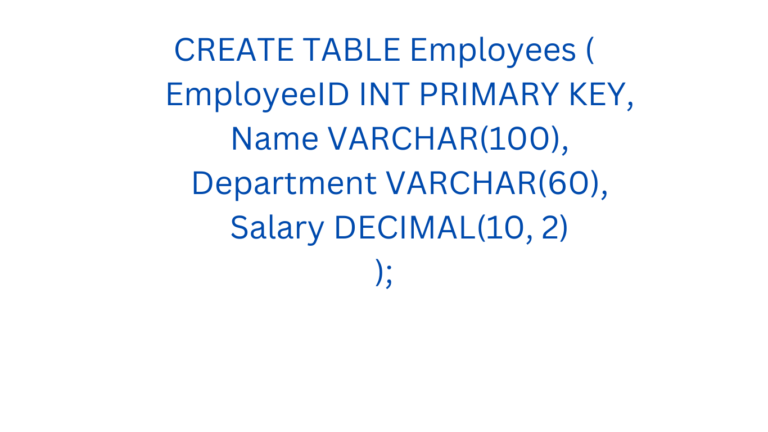Introduction
Database management is based on Structured Query Language (SQL). It enables users to interact with relational databases, providing a way to create, manipulate, and retrieve data. The SQL statements are the commands used for performing out specified database actions.Understanding the types of SQL commands is essential for managing and manipulating data effectively. These commands can be broadly categorized into five types:
- Data Definition Language (DDL)
- Data Manipulation Language (DML)
- Data Control Language (DCL)
- Transaction Control Language (TCL)
- Data Query Language (DQL)
What Are SQL Commands?
SQL commands are instructions used to create, edit, retrieve, and manage data in relational databases, among other things.These commands provide a structured way to work with data and manage database operations. Each type of SQL command serves a specific purpose, from defining the structure of a database to controlling access to its data.
Types of SQL Commands
1. Data Definition Language (DDL)
Database structure is defined and altered using DDL commands. These commands affect the schema of the database, including tables, indexes, and views.
Common DDL Commands:
- CREATE: Used to generate a new view or table in a database.
- ALTER: Changes a database object’s original structure.
- DROP: Deletes a database object permanently.
- TRUNCATE: Delete every record from a table without recording the deletion of any individual rows.
Example:

2. Data Manipulation Language (DML)
Table data is managed using DML instructions. Unlike DDL commands, DML affects the actual data stored in the database.
Common DML Commands:
- INSERT: Adds new records to a table.
- UPDATE: Modifies existing data.
- DELETE: Removes specific records from a table.
Example:
INSERT INTO Employees (EmployeeID, Name, Department, Salary)VALUES (1, 'ABC', 'IT', 5000);
3. Data Control Language (DCL)
DCL commands control user and role permissions and access. These commands ensure security and restrict unauthorized access.
Common DCL Commands:
- GRANT: Assigns specific permissions to a user or role.
- REVOKE: Removes previously granted privileges.
Example:
GRANT SELECT ON Employees TO emp1;
4. Transaction Control Language (TCL)
TCL commands are used to manage database transactions, ensuring data consistency and integrity.
Common TCL Commands:
- COMMIT: Saves all changes made during the current transaction.
- ROLLBACK: Undoes changes made during the current transaction.
- SAVEPOINT: Makes a point that can be rolled back at any point in a transaction.
Example:
BEGIN TRANSACTION;INSERT INTO Employees VALUES (5, 'abc', 'IT', 6000);ROLLBACK;5. Data Query Language (DQL)
Data can be retrieved and queried from the database using DQL commands. The most common DQL command is SELECT.
Common DQL Commands:
- SELECT: Retrieves specific data from one or more tables.
Example:
SELECT Name, Salary FROM Employees WHERE Department = ‘IT’;
Real-World Examples of Each SQL Command Type
DDL Example: An e-commerce company might use the CREATE command to set up tables for products, orders, and customers.
DML Example: A retail chain might use INSERT to add daily sales data into the database.
DCL Example: A bank might use GRANT to provide read-only access to auditors for transaction records.
TCL Example: A stock trading platform might use COMMIT to finalize a successful trade or ROLLBACK in case of an error.
DQL Example: A healthcare organization might use SELECT to retrieve patient records filtered by date and diagnosis.
Tips for Using SQL Commands Efficiently
- Use Indexing: Create indexes on frequently queried columns to improve query performance.
- Optimize Joins: Simplify join operations to reduce computational complexity.
- Batch Processing: For large data manipulations, use batch processing to minimize resource usage.
- Validate Permissions: Regularly review and update permissions to ensure database security.
- Test Before Commit: Always test transactions in a staging environment before committing to production.
FAQs About SQL Commands
Q1: What is the difference between TRUNCATE and DELETE?
A: TRUNCATE removes all rows from a table without logging individual row deletions, whereas DELETE allows selective deletion of rows and supports rollback.
Q2: Can a single SQL statement belong to multiple command types?
A: Yes, some commands like SELECT INTO exhibit characteristics of both DDL and DML.
Q3: How do I handle errors in SQL transactions?
A: Use ROLLBACK to undo changes in case of an error and SAVEPOINT to create intermediate checkpoints within a transaction.
Q4: What are some best practices for writing efficient SQL queries?
A: Use appropriate indexes, avoid using SELECT *, and minimize subqueries when possible.
Q5: What is the significance of DCL in a database?
A: DCL commands are crucial for maintaining database security by managing access and permissions.
